Problem 3 15 pts You and some friends are reenacting Galileo
Problem 3 (15 pts) You and some friends are re-enacting Galileo\'s famous experiment at the Leaning Tower of Pisa (which may, in fact, never have happened but that is a story for another day). During the first trial, your friend drops a cannonball from near the top of the tower. You use a sensor that measures velocity and time which collects the following data: time, t (seconds) velocity, v(t) (meters/second) 0.00 0.50 1.00 1.50 2.00 2.50 3.00 3.50 4.00 0.64 5.33 8.50 14.30 20.84 24.48 30.01 39.30 After doing a quick plot of the data, you notice that it looks quite linear i.e. it looks rather like a straight line). Furthermore, you know from physics class that the velocity of a falling object in a constant gravitational field ignoring air resistance) is given by the equation: r(t) = gt + a where o(t) is the velocity at any time t, g is the acceleration due to gravity and vo is the initial velocity 
Solution
We have
v = u + at
When t = 0, v = 0.64 So, 0.64 = u + a*0 Implies u = 0..64
When t = 1, v = 8.50 So, 8.50 = 0.64 + a*1 Implies that a = 7.86
When t = 2, v = 20.84, So 20.84 = 0.64 + a*2 Implies that a = 10.10
When t = 3, v = 30.01, So 30.01 = 0.64 + a*3 Implies that a = 9.79
v-u = at
b = Ax, v-u = b, A =
A is the time function t (3*1) and x is a ( 1*3)
(b) Ax = b
taking ATAx = ATb
AT is a matrixof order 1*3 and Ais a matrixof order 3*1.
ATA is a matrix multiplication of order 1*1 and ATb is also a matrix multiplication and is of order 1*1.

 Homework Sourse
Homework Sourse